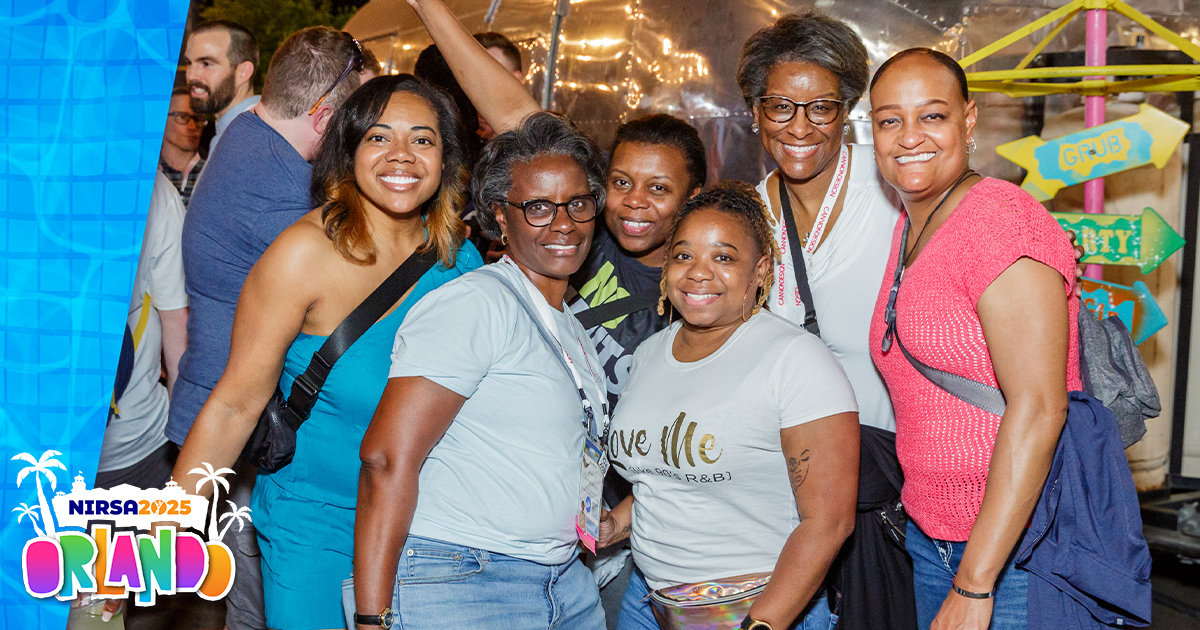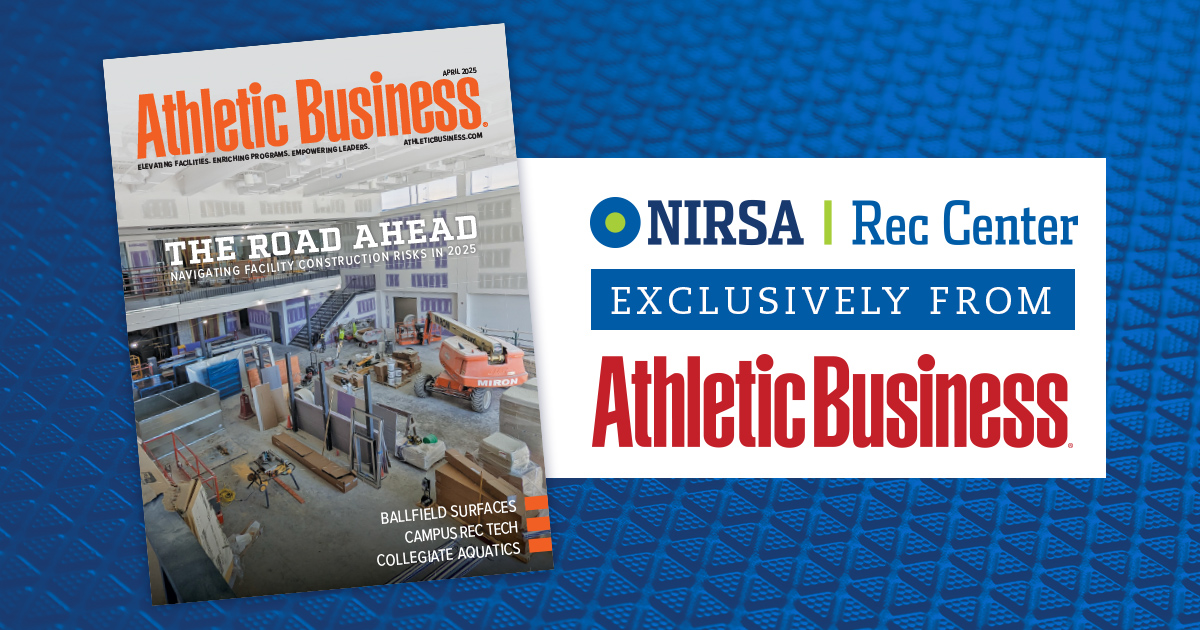Last month, on behalf of NIRSA I had the opportunity to present at the NASPA Annual Conference in San Antonio, TX. With over 6,900 attendees, it is the largest gathering of student affairs professionals in the world and an important stage for campus recreation to have a voice and tell its story.
I was a part of a panel discussion promoting NASPA’s latest student affairs book, Engagement and Employability: Integrating Career Learning through Cocurricular Experiences in Postsecondary Education. NIRSA Executive Director Pam Watts and I cowrote a chapter in Engagement and Employability on campus recreation’s many contributions to cocurricular learning.
Over 160 professionals attended the panel and over 120 stayed afterwards to get their copies of the book signed by its authors, who include executive directors from a variety of student affairs associations. By the time the conference concluded, NASPA had sold all 1,500 first-run copies of the book.
Campus rec is fostering engagement and employability among students
It is no secret that higher education is facing increasingly challenging, and often uncertain, times. Tuition costs continue to rise, states are cutting funding, soundbites of administrative bloat are resounding, competition is increasing for a shrinking pool of potential traditional-age students, and competition for internal resources persists. In such times, it’s imperative that student affairs—and, more specifically, campus recreation—tell its story effectively, demonstrating its value. And, as Engagement and Employability highlights, one of our strongest values is the lifelong skills we foster in our students.
However, if we’re not vigilant in communicating such truths, others—even our higher education peers—can be quick to let outdated notions, overgeneralizations, or misperceptions color how they view campus recreation. To this point, the first question I received during our panel discussion regarded the seemingly—and infamous—“extravagant amenities” (e.g. lazy rivers or 40-foot climbing walls) some rec enters now have. While such questions can feel frustrating for those of us working in the profession, they’re also important because they serve as a reminder of the pervasiveness and persistence of what, for some, is still the first thing to come to mind when considering our field.
I used the question as an opportunity to remind our colleagues that most of our recreation facilities and programs are paid for by students at students’ requests. Often, this comes in the form of students assessing themselves a fee for a healthy opportunity they deem worthwhile and important. Many of the students who make this decision do so knowing they will pay an increased fee towards a project that will be completed after they leave campus. Additionally, most recreation facilities build community with both internal customers—like students, faculty, and staff—and also external customers who are members of the larger community the campus is a part of. Many of these amenities strengthen those community ties.
Leveraging our work as student educators
Campus recreation is, of course, not the only segment of higher education to suffer from misperceptions or even mischaracterizations. NASPA’s President Keven Kruger noted there is a common narrative that administrative bloat in areas such as student affairs is causing a rise in tuition. In reality, though, only 8-10% of the increase in budgets and costs that colleges and university have implemented can be attributed to student affairs.
Our field is, however, one that still flies too easily and too frequently under the radar—even with our student affairs peers. The panel also discussed the fact campus recreation centers are often the largest employers of students on campus; larger university rec centers often employ 500-700 students.
The job skills acquired through employment in and engagement with campus rec—from organization and prioritization to problem solving—are precisely what employers are looking for. Telling that story to university leadership—and to external leaders and lawmakers as well—is critical. Yet many in the audience seemed surprised to learn not only what we do but the scale we do it on.
NIRSA and campus recreation professionals have an opportunity to lean in and leverage the great work we do as student educators to help shape the future of the cocurricular experience in the ever-changing landscape of higher education.
Telling our story to our student affairs colleagues
NIRSA having a seat at the table on this NASPA panel and in Engagement and Employability has allowed us another avenue to tell our story to fellow student affairs professionals and Vice Presidents of Student Affairs. The more our impact on students is understood, the further we can leverage the good work we do. NIRSA and the field of campus recreation are well positioned to be leaders in the emerging model of integrated campus wellness.
Building holistically-healthy people and communities has long been our Association’s goal; the rise of mental health struggles on college campuses has been getting increasing top-down attention from university administrations. Mental health was a strong theme at NIRSA’s 2017 Annual Conference, highlighted by the standalone general session on “Creating a Culture of Wellbeing,” and it was a common thread throughout the NASPA conference too. While some significant inroads have been made by our profession in these areas, there is still a need for more intentional connections with our peers in counseling centers, health centers, and alcohol and other drug (AOD) offices.
Recently, chief student affairs officers cited students’ mental health as their number one concern on their campuses. While attending sessions at the NASPA conference on wellness, mental health, Title IX, and bystander intervention, it was evident to me that NASPA attendees and presenters did not include campus recreation at the forefront of these conversations. If campus rec professionals engage and partner more extensively across their own campuses, recognition and articulation of their leadership in this space will grow.
Learning from our campus partners
In doing so, we’ll learn a lot from our campus partners too. While the field of campus recreation contributed strongly to Engagement and Employability’s message, my coauthors put forth significant expertise as well, which can assist any campus recreation professional in further strengthening the work they do with their student employees.
For example, in one chapter, Marilyn Mackes, the National Association of Colleges and Employers (NACE)’s executive director, articulates the skills and attributes employers are looking for. Many student employees we train or see in leadership roles within our programs attain and sharpen those skills during our trainings and through our mentorship and job opportunities. This provides a good foundation for campus recreation professionals to write learning outcomes for their staff trainings, technical skills trainings, and ongoing job skills development.
Another chapter offers a comprehensive look at Project CEO, which discusses the gap in student’s perceptions of their acquired employable skills and what employers believe. Campus recreation professionals could look at that through the lens of “How we can close that gap in campus recreation?”
Another several chapters cover practical ways employability skills are acquired through cocurricular experiences, providing a global picture of how departments like residence life, student activities, fraternity and sorority life, and campus recreation can work together to offer leadership workshops, trainings, and speaker series to ensure student affairs has a unified voice around our integrality to students’ growth, development, and skill acquisition throughout their college careers.
One of the biggest takeaways from working on Engagement and Employability with my student affairs peers and presenting with them at the 2017 NASPA conference—especially during these uncertain times in higher education—is that now is the time to assert our story. We need to reach out to student affairs departments on our campuses to foster growth in health and wellbeing and tell the story of how we are preparing students for the world after graduation.
- If you are interested in highlighting your campus or a NIRSA member’s achievements on your campus, pitch us your ideas.
- For more information, contact NIRSA’s Director of Advocacy & Strategic Partnerships, Erin O’Sullivan .
David Hall is currently the Director of Campus Recreation at Springfield College; he can be reached at dhall2@springfieldcollege.edu.







